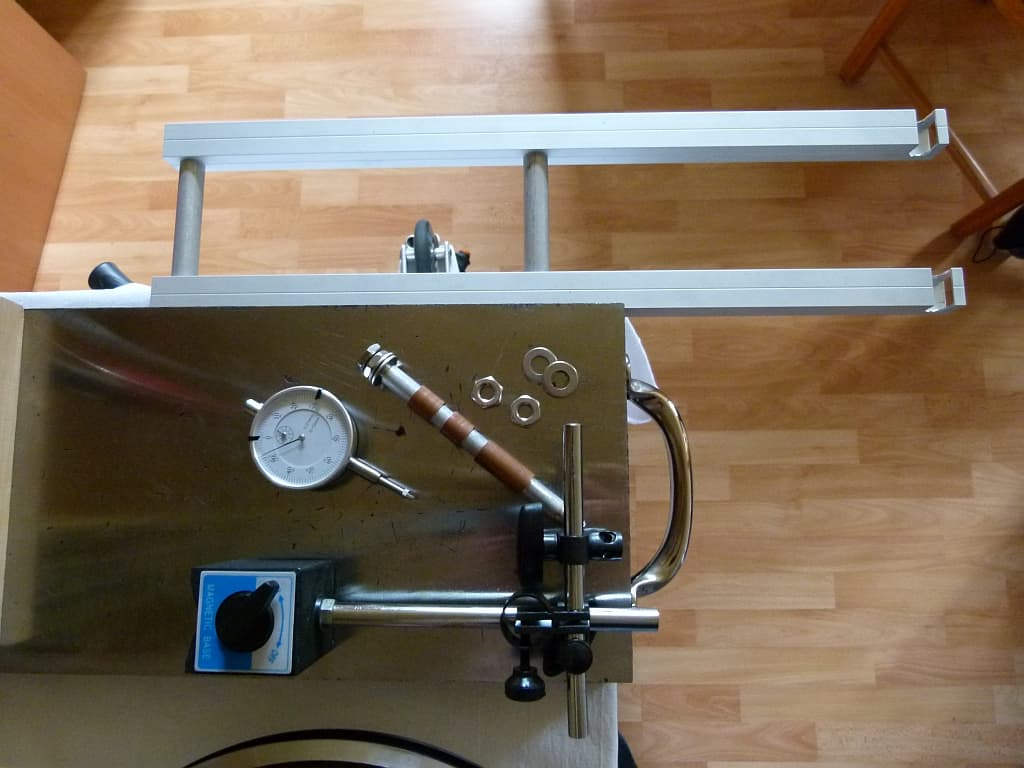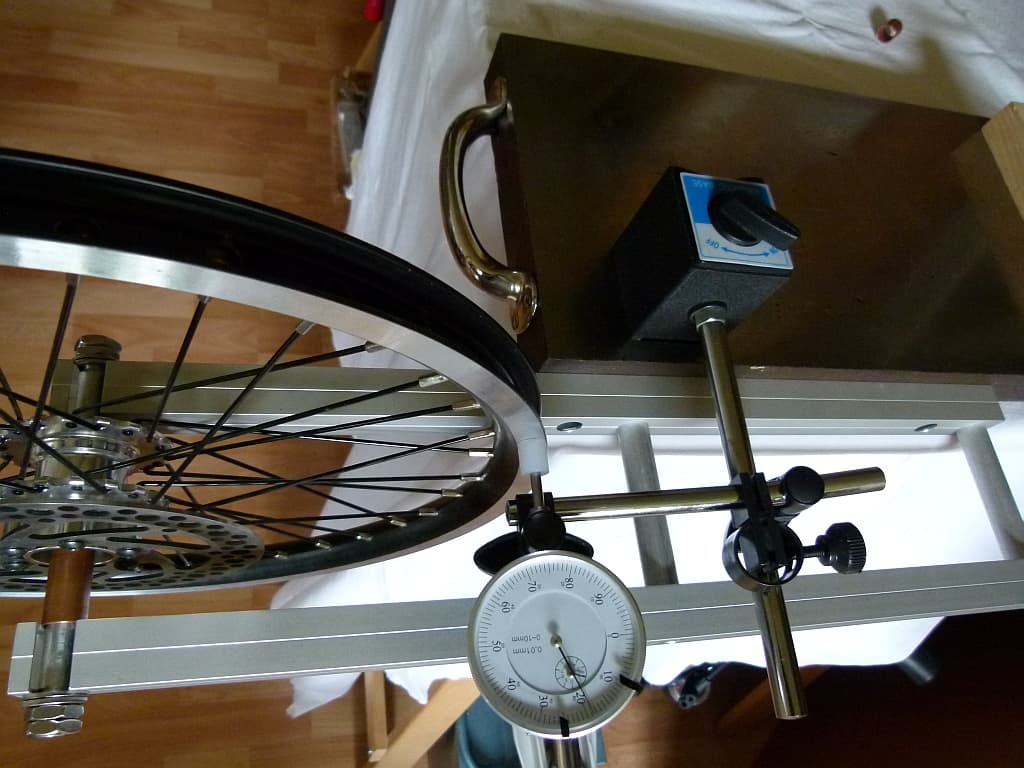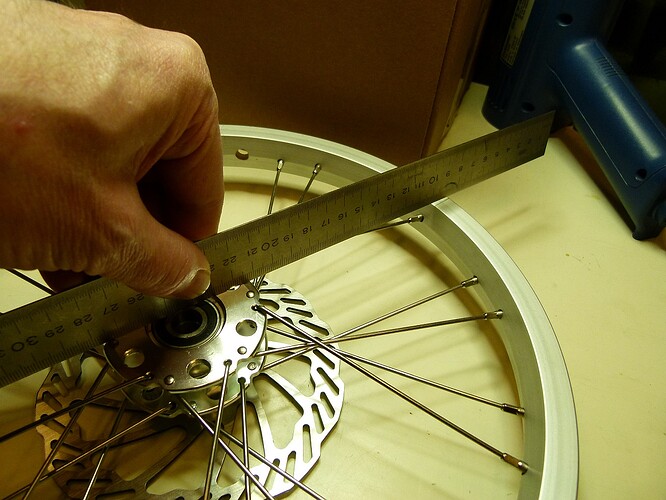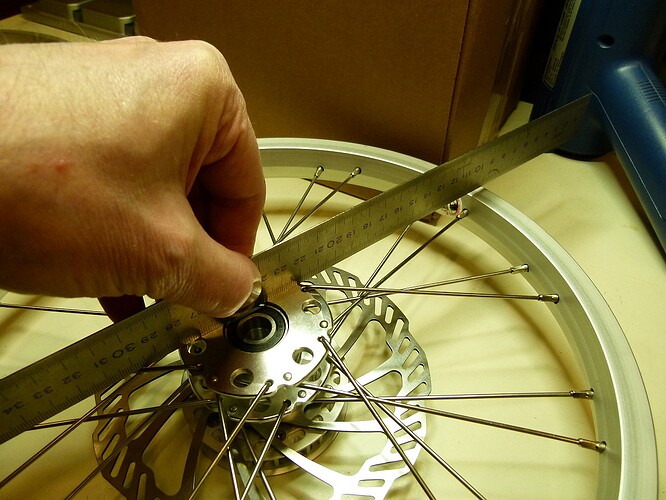Howdy folks,
I’m an experienced wheel builder who needs to true his rear STRIDA 5 wheel. Long story short, some time ago the teeth of the STRIDA belt snapped off and the belt was jammed into the drivetrain. In the end it a disk was warped and rear wheel got out of true. I’ve ordered a new rear disk and plan on truing the rear wheel.
Have folks used a truing stand to work on the wheel? I’m not sure whether the Park stand’s centering tool would reach and if there is enough of axle lip to hold the wheel in place.
Eyeballing it, the rim looks to be in the center of the two flanges and the spokes are equal length. True?
This is a Strida 5 from roughly 7 years ago. I don’t see any markings on the rim. Any idea on max tension specs? The spokes look to be straight gauge … 15? Or is it 14? Even with my caliper, it’s hard to tell the difference between 1.8 and 2.0 mm.
For general context, the wobble is minor and tension generally feels good on the wheel. So I assume it will be a minor adjustment. I figure that while replace the rear disk, I would true the wheel since access would be easier.
Thanks for reading.
EDIT: I just remembered the spoke measuring tool in the tensionmeter box. I’m not near it now, but if no one knows off the top of their head, I’ll measure later and report.
1 Like
Howdy Geoff,
welcome at Stridaforum 
I’ve got good results with a simple trueing “rig”, made of two pieces square tube and two rods plus an axle (and copper spacers with a few nuts).
In this case, the rig was bolted to a massive steel plate, but it could be also clamped onto the work plate. Easy to make, very stable, minimal storage room required.
I should have have all the data you need, I looked already for it (elctronically) but there’s a little problem; all the data sits within some “spc” files, suitable for the ancient wheel calculating software of “machinehead” UK…and that on some old PC…
I’ll try now to find out more (physically)…there should be spoke kits somewhere in my private stock…
Anyway…a bit more info about the thingy above (the old images are maybe misleading), nowadays I’m using two dial gauges…and I do not search for the middle - instead of, I use the wheel outside (outer rim edge) and the hub edge - quick and easy to do with a steel ruler. I have a couple of sketches (somewhere  ) with actual data of made wheel sets.
) with actual data of made wheel sets.
Regarding tensiometer, the (less) of them that I know are not suitable for small wheel spokes due to their construction - I’d recommend the “check-spoketension-by-ear” method.
Finally, there is still an important question left open.
Are we talking about 16" (ETRTO 305) wheels (with 24 spokes)
or 18" (ETRTO 355) wheels with 36 spokes?
Kind regards,
Chris
1 Like
My Strida has 16" (ERTO 305) wheels.
Sweet setup Chris. It looks like the important thing to do is find a big bolt and use some washers with a nut to gently secure it to the truing stand. I have dishing tool which I use at the end of wheel builds: I find it’s more precise than the centering tool.
I did use the pitch method before. I used it when building a e-hub 20" wheel when there was too little space for the tensionmeter. It seems to work well enough over the last 6 years on a triplet. John Allen even has some data for what pitch to listen for. Although if my memory is correct on the length of Strida spokes, it’s below the shortest entry on the chart
Thanks for your help.
1 Like
Pardon me, I’ve edited that above - of course it is ETRTO 305 and not 303.
(I was thinking of Alex Y303 rims  )
)
Meanwhile, I’ve found small packets, labeled by the German distributor, with: “Spoke kit for one 16 inch wheel”, content:
24 spokes in 2 mm thickness and 123 mm length.
Width of original rims approximately 24 - 25 mm.
Below original 16 wheels, steel ruler sits on the hub’s flange, between the spoke heads.
If you have a gap between ruler and rim edge of ~ 2 mm - you’re fine.
Same on the rear wheel. 
To accomplish confusion:
Shown above is the right side of the front wheel, but the left side of the rear wheel! 
1 Like
Awesome. Thank you very much. That’s great information.
The rim to flanges relationship sure did look symmetric when I used my hands to visually block the freewheel and frame. Given that you found a set of spokes for the entire wheel that were the same size and the measurement with a straight edge gives me tons of confidence that it’s supposed to be symmetric.
1 Like
Symmetric…yes, just in relation to what?
If you man in relation to the hub’s flanges - then no.
Simple maths; the width of the hubs is ~ 23 mm.
At the outer side, the rim sits 2 mm inside and it is 25 mm wide.
At the inner side, the rims sits ~ 4 mm outside - which is the difference between 27 and 23.
The middle of the hub is at 11,5 mm, but the middle of the rim is at 14,5 mm.
In other words, the rim has to be dished inwards for 3 mm (in relation to the hub flanges). 
1 Like
Oh … I read your response too fast. When I take off the wheel and have it in my hands, I’m sure I’ll digest what you wrote above.
1 Like



